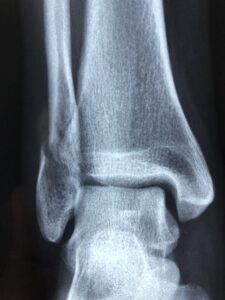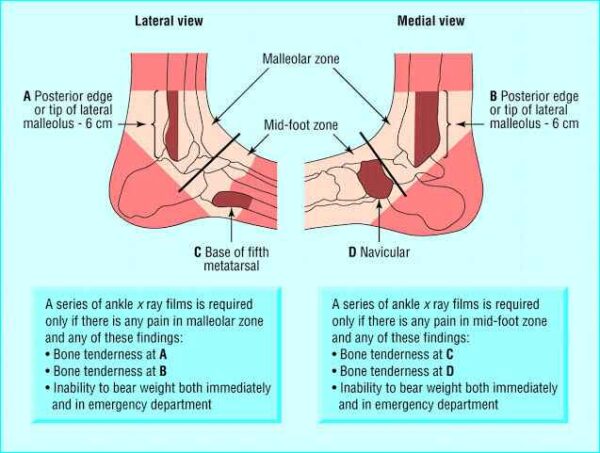In This Article
Are you getting super frustrated, wondering why your ankle sprain is not getting better?
When you sprain your ankle, we often assume that you’ve just torn some ligaments.
But there’s so much more that can go wrong and delay your recovery!
It’s hard to tell at first – ever ankle sprain hurts like hell and usually swells.
But weeks later, it’s just not feeling right!
You’re still having pain when you walk and your ankle sprain is not getting better.
Our Physiotherapists will explain what happens in a sprained ankle and how to figure out why your ankle sprain is not getting better.
What happens when you sprain your ankle?
Anatomy of the ankle

Firstly you’ll need to visualise the design of the ankle joint.
It’s essentially a square-shaped bone (the Talus) sitting in a square-shaped space (formed by the Tibia and Fibula).
The main function of this joint is forward/backward movement (known as Plantarflexion and Dorsiflexion).
There’s a little bit of room on either side of the joint which accommodates some sideways tilting as well.
Where the bones touch, they have a smooth surface (joint cartilage) designed to allow easy movement under load.
Holding all that together is a wall of connective tissue surrounding the whole joint (the joint capsule).
That capsule has a sensitive, water-tight lining (known as the synovium).
Bracing that capsule is a number of ligaments, strong bands of connective tissue that connect bone to bone and restrain movement.
The action of spraining an ankle
The most commonly known injury from an ankle sprain is a torn ligament.
This usually involves ATFL (Anterior Talofibular Ligament) and CFL (Calcaneofibular Ligament) on the outside of the ankle.
They are the primary restraints of that movement and the first to go.
After each sprain, the ligaments recover but they don’t heal back to 100% capacity.
You’ll likely get about 50-70% of their pre-injury function.
A typical ankle sprain takes between 2-6 weeks to recover, although there’s a huge range of factors that can affect your recovery timeframes.
As a general rule, you should be seeing some improvement after two weeks – more comfortable while walking, less swelling and no constant ache.
If your ankle sprain is not getting better after two weeks, you might have a significant ligament injury that will just take longer or a secondary injury that’s delaying recovery (we detail those in the next section).
With each subsequent sprain, the primary restraints are less capable and the rest of the joint structures may take some of the sudden overload.
So your chance of secondary injuries increases with each sprain, which is why recurrent sprainers are more susceptible to cartilage and other injuries.
Secondary damage can also happen in a first time sprain but it takes a lot more force.
Reasons why your ankle sprain is not getting better
If the primary ligaments don’t effectively restrain the joint, the joint gets pushed beyond its normal limits.
As it rolls, it rapidly stretches the joint capsule, its sensitive lining and the bracing ligaments.
The Talus, a square shaped bone, rotates inside the square joint space made up of the Tibia and Fibula.
That potentially causes bones to bump into each other.
This creates a bone oedema (aka. bone bruise), much like a kick in the shin.
It also causes swelling inside the joint and a constant dull ache with prolonged activity.
The joint capsule will also overstretch, along with its sensitive joint lining.
The capsule is typically undamaged but the lining reacts, creating an inflammatory response (known as synovitis) that is painful to stretch or compress.
As the joint surfaces moved rapidly off alignment, the smooth cartilage can be bruised or gouged.
This creates bone bruising and swelling inside the joint, which further stretches and aggravates the joint lining.
Joint cartilage damage occurs in around 7%, or 1 in 14, ankle sprains.
With strong force of the bones that form the square space over the ankle, the bones can get forced apart, damaging the ligaments above the ankle.
If the ligaments hold, the bone on the outside of the ankle may fracture (see the x-ray image above and look closely at the Fibula for a spiral fracture).
Any of these secondary injuries, whether it’s cartilage, bone or just inflammation, will slow down your recovery.
It explains why some ankle sprains bounce back quickly and some just don’t.
Should you get a scan if your ankle sprain is not getting better?

Soon after your sprain, your doctor or Physio can decide if an X-ray is needed.
They use a criteria called the Ottawa ankle rules.
It doesn’t provide a diagnosis but checks for the site of common fractures from ankle sprains.
If your ankle sprain is not getting better after a few weeks, you may require an MRI.
MRI provides detail of bone, ligaments, tendons, cartilage and inflammation – it can image every tissue type so it’s great at spotting an complicating pathologies or other damage to explain why your ankle sprain is not getting better.
They’re expensive so you wouldn’t get referred for one unless it’s really necessary for your medical management.
But if your ankle sprain is not getting better and you’re just not making progress, an MRI is a vital component in our management to steer your rehab in the right direction.
Summary of primary and secondary pathologies in an ankle sprain
Here’s a list of common injuries that can occur with an ankle sprain.
| DESCRIPTION | DIAGNOSIS |
| Lateral ligament damage after rolling an ankle, causes bruising and swelling. | Ankle ligament injury |
| Cartilage damage inside the ankle causing recurrent swelling and a deep ache on weight bearing. It can become chronic and cause ongoing issues. It’s difficult to diagnose in the clinic so you suspect this if your ankle sprain is not getting better after 6 weeks. | Talar dome lesion |
| A reaction around the joint. Produces sharp pain and ongoing ache. It’s one of the most common reasons why an ankle sprain is not getting better and can cause recurrent swelling. | Talocrural synovitis |
| Impact to the bones inside the ankle, this is felt as a deep ache and causes some swelling. | Bone oedema (aka “kissing lesion”) |
| Damage to the ligament/s above the ankle joint, this causes pain with dorsiflexion (knee moving forwards) . | Syndesmosis injury |
| A complication of a sprain, the bone on the outside of the ankle can fracture. | Fibula fracture |
| The soft tissue or bones around the joint can pinch together on movement, causing a sharp pain and residual ache. One of the more common reasons why an ankle sprain is not getting better. | Talocrural (ankle) impingement |
| The joint below the main ankle joint, it’s often strained in the same incident and causes pain on impact or uneven ground. | Subtalar joint irritation |
